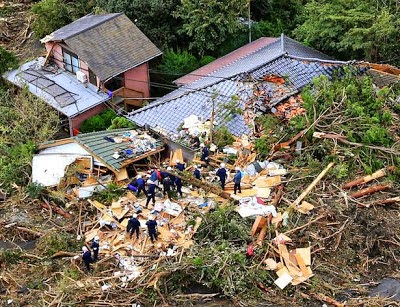Two people have been confirmed dead and about 100 more have been injured after Typhoon Vongfong passed over the Tohoku Region of Japan on Tuesday 14 October 2014. The two fatalities have been described as males aged 72 and 90, both of whom appear to have drowned. The storm also caused about 30 injuries as it passed over the island of Okinawa on Sunday 12 October. The typhoon caused a storm surge which is reported to have led to widespread flooding, particularly around the city of Kesennuma, where the ground level was lowered by the 2011 Earthquake, and about 800 000 people were advised to leave their homes ahead of the storm, though no mandatory evacuation was organised. Around 150 000 homes have reportedly been left without electricity.
Damage caused by Typhoon Vongfong in Kagoshima. Yomiuri Shimbun.
Tropical storms are caused by solar energy heating the air above the
oceans, which causes the air to rise leading to an inrush of air. If
this happens over a large enough area the in rushing air will start to
circulate, as the rotation of the Earth causes the winds closer to the
equator to move eastwards compared to those further away (the Coriolis
Effect). This leads to tropical storms rotating clockwise in the
southern hemisphere and anticlockwise in the northern hemisphere.These
storms tend to grow in strength as they move across the ocean and lose
it as they pass over land (this is not completely true: many tropical
storms peter out without reaching land due to wider atmospheric
patterns), since the land tends to absorb solar energy while the sea
reflects it.
The low pressure above tropical storms causes water to rise there by ~1 cm for every millibar drop in pressure, leading to a storm surge that can overwhelm low-lying coastal areas, while at the same time the heat leads to high levels of evaporation from the sea - and subsequently high levels of rainfall. This can cause additional flooding on land, as well as landslides, which are are a common problem after severe weather events, as excess pore water pressure can overcome cohesion in soil and sediments, allowing them to flow like liquids. Approximately 90% of all landslides are caused by heavy rainfall.
See also...
The crash of a TransAsia Airways ATR-72 passenger plane in the Penghu Islands on Wednesday 23 July 2014 has been linked to the passage of Typhoon Matmo across the area. Around 200 flights to and from Taiwan had been cancelled earlier in the day, but the typhoon had passed into Chinese territory by the time Flight...
 At least 17 dead as Typhoon Wipha hits Japan. Seventeen people are known to have died and several more are missing
after Typhoon Wipha made landfall in Japan on Wednesday 15 October 2013.
The majority of the deaths occurred on Izu Oshima Island, a popular
tourist resort 120 km to the south of Tokyo, where 122...
At least 17 dead as Typhoon Wipha hits Japan. Seventeen people are known to have died and several more are missing
after Typhoon Wipha made landfall in Japan on Wednesday 15 October 2013.
The majority of the deaths occurred on Izu Oshima Island, a popular
tourist resort 120 km to the south of Tokyo, where 122...  One person confirmed dead and two more missing as Typhoon Man-yi hits Japan. A 71 year old woman has been confirmed dead after a landslip hit her
home in Ritto City in Shiga Prefecture, Japan, on Monday 16 September
2013 following heavy rains associated with Typhoon Man-yi...
One person confirmed dead and two more missing as Typhoon Man-yi hits Japan. A 71 year old woman has been confirmed dead after a landslip hit her
home in Ritto City in Shiga Prefecture, Japan, on Monday 16 September
2013 following heavy rains associated with Typhoon Man-yi...
Follow Sciency Thoughts on Facebook.



